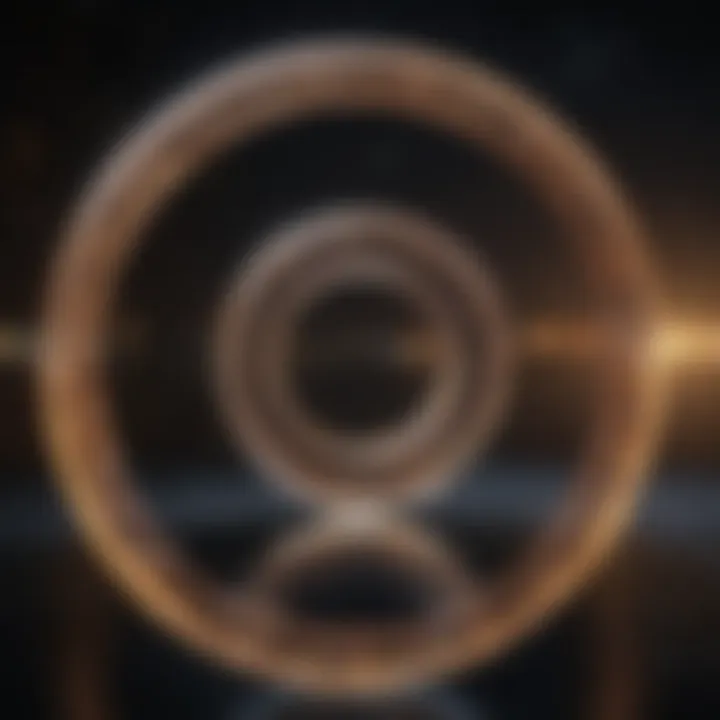Understanding Infinity: Its Value and Context


Intro
Infinity is not just an abstract concept; it weaves through the very fabric of mathematics, philosophy, and science. To truly grasp what infinity embodies requires recognizing its myriad interpretations and the ways it influences our understanding of the universe.
This exploration isn’t just academic; it touches the core of how we perceive existence, time, and space. As we journey through the various fields where infinity holds sway, from calculus and set theory in mathematics to the thought-provoking realms of philosophy and the cutting edge of contemporary science, we’ll peel back the layers to expose the relevance and richness of this infinite concept.
In the upcoming sections, we aim to synthesize key research findings, break down complex theories, and provide visual aids to enhance understanding. The goal here is not only to illuminate the meaning of infinity but also to show its practical and theoretical applications in a world that increasingly relies on these abstract ideas.
The Concept of Infinity
The notion of infinity stirs up a whirlwind of thoughts and ideas, often leading people down a rabbit hole of philosophical and mathematical contemplation. But why is understanding the concept of infinity so crucial? It’s not just an abstract idea; it impacts mathematics, philosophy, science, and even our daily thoughts about the universe.
Infinity offers a foundational lens through which we can interpret physical phenomena, numeracy, and ethical dilemmas. When pondering infinity, one begins to recognize its ubiquitous nature in life and the universe. It’s about grasping an idea that stretches beyond common sense, yet serves as an essential building block in many areas of scholarly pursuit.
Understanding infinity helps us explore profound questions about existence, mathematics, and the structure of the cosmos. The implications can be vast; grasping how things can be endlessly divisible, or how the universe may operate without bounds can reshape perspectives.
Definition and Basic Understanding
When it comes down to it, defining infinity may seem like trying to peg jelly to a wall. Infinity isn’t a number in the traditional sense; rather, it’s a concept that represents an unbounded quantity. Think about it like this—when we say a set of numbers is infinite, we are saying it goes on and on without any limits. For instance, the numbers 1, 2, 3… continue infinitely.
To become more familiar with infinity, one can distinguish between different types of infinity. Potential infinity describes a process that can keep going without end, while actual infinity refers to a completed set that is infinite. For example, imagining the process of counting is potential, whereas the set of all natural numbers is considered actual.
Historical Perspectives on Infinity
The idea of infinity has roots that reach deep into human history, mingling with philosophical thought and mathematical innovation. Starting with Ancient Greece, Zeno of Elea is famous for paradoxes that challenge our understanding of infinity, like the Achilles and the Tortoise. Through his work, he showcased the contradictions that arise when one attempts to grasp the infinite.
Later, during the Middle Ages, thinkers like Nicholas of Cusa began to delve deeper into the relationship between the finite and the infinite. He asserted that the divine is the infinite nature of God—a concept influencing both philosophical thought and theological discourse. Fast forward to the 17th century, and Galileo Galilei explored infinity through his discovery that some infinities can indeed be larger than others, paving the way for modern set theory.
Infinity in Various Cultures
Infinity isn't only a concept found in Western thought; other cultures have their interpretations. In Hindu philosophy, for instance, the term Ananta translates to infinite, embodying the limitless nature of the universe and existence. Similarly, in Buddhist teachings, the idea of infinity relates to the concept of Nirvana, transcending the finite constraints of worldly life.
Whether it’s through ancient texts or contemporary philosophical discussions, cultures have long held infinity as a vital truth underpinning both the seen and unseen worlds. These diverse perspectives enhance our understanding of infinity, showing it’s not a monolithic concept but rather a tapestry woven with various threads of human thought.
Understanding infinity invites us to question our assumptions about boundaries and existence throughout cultures.
By unpacking the concept of infinity, its definitions, historical perspectives, and cultural representations, one can appreciate how fundamentally it influences various fields of study. This exploration serves as a cornerstone to better grasp the implications infinity has in mathematics, philosophy, and beyond.
Mathematical Representations of Infinity
The subject of mathematical representations of infinity is a critical aspect of understanding how infinity operates within various mathematical contexts. Whether it's calculus, set theory, or proofs, grasping these representations is essential for both advanced mathematics and its practical applications in fields like science and technology. The ability to conceptualize infinity not only enriches mathematical theory but also provides insights into the universe's nature, revealing profound consequences and implications. Discussing these representations enables us to remove the veil of misunderstanding that often surrounds this elusive concept, making it more tangible and relevant to the reader.
Infinity in Calculus
Limits and Convergence
Limits and convergence are foundational concepts in calculus, serving as the building blocks for understanding infinity in a more rigorous way. At the heart of limits lies the idea of approach: as values get closer to a certain point, we can explore their behavior at that infinitesimal boundary. This is crucial for defining continuity and differentiability in functions. The beauty of limits is their ability to metamorphose sequentially defined functions into continuous forms, effectively tying together discrete mathematics with continuous theories, which is a well-liked trait in the study of infinity.
One unique aspect of limits is their role in determining whether a series converges or diverges, thus directly affecting calculations. If a series converges to a limit, it’s like finding a home base for otherwise unpredictable behavior—a kind of mathematical harbor where certainty and chaos coalesce. Conversely, when a series diverges, it flirts with infinity, illuminating the boundary between the finite and the infinite, which can be both a blessing and a curse for mathematicians.
"The limit can be a bridge between the known and the unknown, leading toward infinity's vastness, yet without losing connection to the finite realm."


Approaching Infinity
Approaching infinity in calculus is all about examining how functions behave as they approach infinitely large or infinitely small values. Here, the key characteristic is the asymptotic behavior of functions, which illustrates how these functions can be drawn ever nearer to infinity without actually reaching it. This nuanced concept helps students and practitioners understand what it means to “approach the infinite,” unveiling a layer of mathematical language that many find striking.
When utilizing this concept, one might notice that it prompts new questions and further exploration, especially in advanced studies such as topology or complex analysis. Consequently, it offers an intriguing perspective where infinite potential resides without definitive resolution. However, one must tread carefully: grappling with approaching infinity often entangles students in the complex realities of limits, which can lead to misunderstandings if not approached with diligence.
Set Theory and Cardinality
Countable vs. Uncountable Infinity
In set theory, infinity takes on various colors, with countable and uncountable infinities drawing distinct lines that play a profound role in mathematics. Countable infinity can be likened to the natural numbers: you can enumerate them, even if the list goes on forever. But the moment you introduce uncountable infinity, like the real numbers, you're stepping into an entirely different universe. This distinction is a key characteristic that makes this topic essential for understanding infinity more broadly.
Recognizing this divide is not simply an academic exercise; it has far-reaching implications. For instance, in discussions about the continuum hypothesis, one grapples with the possibility of sets that fall between countable and uncountable. The uniqueness of each type of infinity informs countless areas, from computer science to quantum physics, offering rich avenues for exploration.
Different Sizes of Infinity
The idea that there are different sizes of infinity is perhaps where mathematics reveals its most surprising facets. This notion demystifies infinity, suggesting that some infinities are indeed larger than others—an abstraction at once elegant and perplexing. It invites students to dive deeper into concepts such as cardinality and the hierarchy of infinities, which provides clarity on how different sets relate to one another.
The distinct sizes of infinities highlight the way mathematical thinking continuously evolves, inviting ongoing examination and curiosity. However, the inherent complexities can lead to confusion if not approached with an open mind and proper guidance. The key takeaway here is that understanding these sizes encourages mathematicians to appreciate the richness of mathematics beyond mere numbers or functions.
Infinity in Mathematical Proofs
Proof by Contradiction
Proof by contradiction is a powerful method where one assumes an assertion is false to reveal a contradiction. This technique is especially prevalent in discussions involving infinite sets or properties related to infinity itself. Why is this method significant? It instills a methodical approach to navigating complex ideas, often yielding clarity where direct proof falters. It acts as a crucible for rigorous mathematical thinking, forcing scholars to confront the limitations of their arguments.
The unique feature of proof by contradiction is its ability to ascertain truths through negation, guiding researchers to uncover unexpected insights in their studies of infinity. However, while this approach is highly effective, it does require a keen sense of logical reasoning and can sometimes lead students astray if they misinterpret foundational assumptions.
The Infinitude of Primes
The infinitude of primes is a classic mathematical concept, with its roots stretching back to Euclid. It asserts that prime numbers do not stop, unveiling a limitless realm within the number system itself. This supporting idea elegantly integrates with the broader discussion of infinity by showing how even within the confines of numbers, one can witness an unending quest for understanding.
This topic is appealing for its simplicity juxtaposed with profound implications. Its role in cryptography shows practical applications of seemingly abstract concepts. When understanding this infinitude, one sees not just numbers but a philosophical insight into the endless pursuit of knowledge. Nevertheless, navigating prime numbers can complicate matters slightly, especially for those unseasoned in mathematical abstraction.
In summary, mathematical representations of infinity stretch across a vast landscape, from calculus to set theory and proofs. By illuminating the balance of understanding and complexity involved, one gains a fuller appreciation for this intriguing topic and its relevance within both mathematics and the wider scientific discourse.
Philosophical Implications of Infinity
The exploration of infinity extends beyond mathematical formulas and scientific models. It beckons a deeper inquiry into philosophical questions that shape our understanding of existence, ethics, and reality itself. The philosophical implications of infinity require us to ask fundamental questions about the universe and human thought, making it an essential topic in this article. Delving into infinity's metaphysical and ethical dimensions allows us to grapple with ideas that challenge our perceptions of meaning, free will, and morality.
Infinity in Metaphysics
The Nature of the Infinite
When pondering the nature of the infinite, one cannot escape the complexity it introduces into our understanding of reality. Many philosophic traditions emphasize that the infinite isn’t merely a mathematical abstraction; it's a critical lens through which we comprehend existence. A key characteristic of the infinite is its boundlessness, which invites both intrigue and confusion. This aspect of infinity, while appealing to scholars, presents challenges in articulating its significance in our finite world.
Unique Feature: The primary charm of this concept lies in its implication that not everything can be contained or neatly wrapped within our human understanding. This invites creativity in philosophical discussions. However, its limitless nature can lead to nebulous conclusions, making it difficult to assert concrete beliefs.
Thus, engaging with the nature of the infinite enriches our discourse, encouraging thinkers to transcend conventional boundaries in their quests for truth. The understanding of the infinite can lead to enhanced explorations in metaphysics, as well as differing perspectives on existence itself.
Infinity and Existence
The relationship between infinity and existence forms a fascinating dialogue in philosophy. The question arises: if the universe is infinite, what does this mean for our existence? A notable characteristic of this inquiry is the contrast it draws between the finite nature of human life and the seemingly eternal cosmos.


This notion extends to thinkers who argue that our attempts to define existence fall short when confronted with the infinite. The unique feature of assessing existence through the lens of infinity highlights a profound realization: human existence may appear fleeting against the vast, ungraspable background of infinity.
Advantages and Disadvantages: Engaging in this philosophical exploration offers profound insights into human purpose and meaning, but it also risks invoking existential dread. As we come to terms with the might of the infinite, we can appreciate both our significance and our impermanence, making this a worthwhile topic for discussion.
Ethical Considerations and Infinity
Moral Absolutes vs. Infinite Choices
The interplay between moral absolutes and infinite choices challenges us to wrestle with ethical frameworks that define our actions. One striking element of this consideration is the realization that with infinite choices comes a layered complexity in decision-making. Human beings often seek moral certainties, yet the presence of endless possibilities complicates these solutions.
Key Characteristic: This duality reflects the tension in our ethical intuitions. The ability to make infinite choices imbues individuals with freedom but also burdens them with the responsibility of consequence.
This discussion provokes critical thought about how ethical systems can accommodate the vastness of potential actions. Positions like consequentialism might arise as a means to reconcile this framework with practical outcomes, yet moral absolutes often provide the comfort of clarity in an otherwise chaotic moral landscape.
Consequentialism and Infinite Outcomes
Consequentialism, which measures the morality of actions based on outcomes, dovetails neatly with the notion of infinite possibilities. This theory recognizes that an action can lead to an infinite number of results, emphasizing the importance of considering the broader ramifications of our choices. One key characteristic here is that it liberates ethical inquiry from rigid dogmas, allowing for a flexible approach to morality.
Unique Aspect: Examining the ethical landscape through the lens of infinite outcomes not only expands our understanding of moral philosophy but also propels our examination of real-life implications. The challenge lies in anticipating the potential ripple effects of our actions in an infinitely complex world.
Applications of Infinity in Science
The application of infinity in science is multifaceted and profound, extending from physics to computer science. Understanding infinity allows researchers and practitioners to grapple with concepts that exceed finite limitations. This exploration goes beyond simple numerical calculations, affecting how we understand the universe’s structure and the computational processes driving technology today. The ability to conceptualize infinity aids in providing insights into the functioning of the cosmos and the logical foundations of modern data-driven disciplines.
Infinity in Physics
Cosmology and the Infinite Universe
In the realm of cosmology, the infinite universe is a concept that serves as a fundamental pillar for understanding the cosmos. One primary aspect of this infinite framework is the idea that the universe might have no boundaries—space stretching infinitely in all directions. This notion is not merely theoretical; it opens a geyser of possibilities about the nature of existence itself. With theories suggesting the universe is expanding indefinitely, this attribute offers a significant perspective into how galaxies behave and evolve over time.
The key characteristic of the infinite universe in cosmology is its capacity to challenge traditional boundaries imposed by human perception. This characteristic makes it a popular choice for scientific inquiry as it invokes a depth of curiosity about our place in the grand scheme. The unique feature here is the interplay between finite observation and infinite reality. Despite our constrained view of the universe through telescopes and scientific models, the implication that larger structures beyond our understanding exist keeps researchers probing deeper.
However, grappling with infinity in cosmology does have its downsides. While it offers profound comprehension, it also leads to paradoxes that can be perplexing. For instance, dealing with infinite distances and how they relate to empirical measurements can make theoretical models mathematically intense and sometimes impractical.
Quantum Mechanics and Infinity
In quantum mechanics, infinity surfaces through discussions of probabilistic models and theories. A key aspect here is the way particles behave at subatomic levels, where traditional concepts of particles’ locations and velocities start to break down, manifesting as waves that signify probabilities rather than certainties. Infinity enters the conversation when analyzing these wave functions which extend over infinite space, suggesting that outcomes may be infinitely variable—an unsettling yet fascinating characteristic of quantum events.
This aspect of quantum mechanics is pivotal because it spurs questions about determinism and randomness at the atomic level. The emphasis on infinite possibilities makes it a rich area for exploration. Quantum mechanics provides a unique feature whereby the infinite potential outcomes of particle interactions result in practical applications, like how semiconductors and quantum computers operate today.
Though exciting, the complexity of infinity in quantum mechanics can create substantial challenges. For instance, attempting to visualize or represent these infinite outcomes can lead to models that are abstract and difficult for even seasoned physicists to comprehend, leading one to wonder if our finite minds can truly grasp the infinitude.
Infinity in Computational Theory
Algorithms and Infinite Processes
Algorithms that tackle infinite processes are another striking example of infinity in computational theory. Many computational problems require processes that iterate indefinitely until a condition is met or a steady state is observed. In such scenarios, algorithms are designed to handle and process data as if it were infinite, leading to solutions that are not merely functional but also innovative.
The key characteristic of algorithms engaged with infinite processes is their efficiency and adaptability. They exemplify how to manage potentially unbounded datasets—an essential for big data applications. The advantage of understanding and applying infinity in algorithm design is that it allows for the creation of robust tools capable of addressing complex problems across various fields.
Yet, crafting algorithms to handle infinite scenarios comes with its challenges. Undoubtedly, inefficiencies can emerge if not properly designed, leading to loops that consume resources without yielding results.
Infinity in Data Structures


The concept of infinity in data structures primarily comes into play when dealing with linked lists, trees, and graphs that can expand beyond predefined limits. The principle here suggests that a data structure could theoretically grow infinitely as more data is added. This expands the usefulness of structures by enabling programmers to adapt to unseen demands.
Highlighting the flexibility of infinity in data structures enhances the understanding of computational scalability. This feature makes such structures incredibly popular in software design and architecture. The principal advantage of integrating infinity here is that it allows systems to be more memory efficient, yet still able to process large quantities of data.
However, working with infinite data structures means that programmers must remain vigilant against pitfalls like endless memory consumption and retrieval time issues. Balancing the benefits of infinite scalability with practical limitations is crucial to harnessing the potential of infinity in a meaningful way.
"Infinity is not just a measure; it’s an experience that drives both theoretical insights and practical applications across the vast domains of science and technology."
Contemporary Perspectives on Infinity
Understanding infinity today goes beyond mere mathematical definitions and dives into the realms of science, culture, and philosophy. These contemporary perspectives on infinity are crucial as they help to connect theoretical concepts with practical, everyday applications. Modern thinkers grapple with how infinity affects our understanding of the universe, technology, and even our beliefs.
Infinity in Current Scientific Research
In scientific fields, infinity plays a pivotal role, especially in areas like cosmology and theoretical physics. Researchers often encounter scenarios where infinity becomes a concept to tackle, such as the infinite nature of the universe or the infinite divisibility of space and time. For instance, when studying black holes, the idea of infinite density at a singularity poses significant questions about the laws of physics as we understand them. The exploration of these infinite scenarios prompts scientists to challenge established theories, leading to potential breakthroughs.
Moreover, infinity in mathematical models aids in understanding phenomena like chaos theory and fractals, which describe complex systems that exhibit unpredictable behavior. The ongoing research into how these infinite aspects function assists in formulating more accurate predictions about various scientific inquiries.
Public Perception of Infinity
The way people understand infinity is influenced by multiple factors, including exposure through education, art, and media. Public perception often shapes how concepts are interpreted in popular culture and used in various contexts, illustrating the importance of guiding this understanding wisely.
Infinity in Popular Culture
Infinity has become a popular motif in literature, movies, and art. Consider films like "Interstellar," where the narrative dives into the effects of time dilation and the vast, seemingly infinite universe. Such portrayals encapsulate the imaginative possibilities of infinity, making it approachable to a wider audience. This representation is beneficial for this article as it shows how complex scientific ideas can transcend into familiar narratives, generating interest and curiosity among those not specialized in the subject.
One unique feature of infinity in popular culture is how it ignites discussions about existence and the universe. It stimulates debates about the nature of reality, encouraging people to reflect on their place within this vast expanse. However, there is a downside: the romanticism of infinity can sometimes lead to misunderstandings about its scientific implications, creating confusion rather than clarity.
The Impact of Technology on Understanding Infinity
Technology has revolutionized how we explore and grasp the concept of infinity. For instance, advancements in computer science allow for simulations that visualize infinite processes, such as rendering fractals. These practical applications can clarify abstract notions and make them more palatable for learners.
A significant characteristic of technology in this context is its ability to democratize knowledge. With tools like educational apps, online courses, and interactive platforms, a myriad of resources are available to explain complex ideas about infinity. This approach enriches understanding and engages a broader audience, making it a popular choice for the article.
Another unique feature is the way technology fosters collaborative discussions. Platforms such as Reddit host communities that explore philosophical and scientific inquiries surrounding infinity, allowing diverse viewpoints and fostering deeper comprehension. Nonetheless, it’s important to recognize that technology also has limitations, as it can sometimes perpetuate misinformation if not moderated effectively.
Culmination: The Value of Infinity in Understanding Our Universe
Infinity is more than just a concept languishing in the realm of mathematics; it weaves its way through various disciplines, playing a crucial role in the quest for knowledge and understanding of our universe. By grappling with infinity, we confront the boundaries of human cognition and explore notions that seem beyond our grasp. This exploration leads to a richer comprehension of the natural world and its underlying principles.
The significance of infinity emerges in diverse contexts such as mathematical theory, philosophical discourse, and scientific inquiries. Each of these fields offers distinct insights that reflect our human endeavor to make sense of complexities. Infinity challenges us to think beyond the finite, propelling our understanding of universe-creating models, like cosmology. Here, infinity aids in grasping the concept of an everlasting universe, inviting us to question physical limits and how they define existence.
Additionally, the implications of infinity extend into ethical discussions. When pondering moral absolutism versus infinite choices, we encounter a nuanced dialogue about the consequences of our actions. Through acknowledging infinite outcomes, we become more aware of the weight our decisions carry.
"To understand the universe, we must first embrace the infinite potential of what lies beyond our current comprehension."
Reflections on Infinity's Role
The role of infinity is multifaceted. It serves not only as a mathematical abstraction but also shapes the way we perceive time, space, and existence. Mathematical constructs, such as limits and divergence, provide tools to approach real-world phenomena. For instance, when scientists evaluate the behavior of light or sound, they often reference infinity to predict how systems evolve over time. This interplay between the finite and infinite underscores the absolute necessity of thinking outside conventional limits.
Moreover, in philosophy, infinity inspires deep reflections on the nature of existence itself. The comparison of the infinite to the finite illuminates our understanding of reality, and each philosophical inquiry into infinity unveils layers of complexity about the human experience, influencing how we shape our interpretations of life.
Future Directions in Infinity Studies
Looking ahead, the study of infinity is poised to evolve dramatically. With the rapid advancements in technology and mathematics, explorations into infinity will likely burgeon. Research in quantum mechanics provokes further questions regarding the infinite aspects of particles and their behaviors, indicating a possible synergy between thought and empirical science. This field is ripe for discovery, as the principles surrounding infinity fuel new hypotheses about the very nature of quantum realities.
Additionally, interdisciplinary approaches are essential. Collaborations among mathematicians, philosophers, and scientists can create a collective understanding that transcends individual fields. Expect more dialogues to emerge that fuse these perspectives, potentially leading us to innovative theories and applications. Infinity not only enriches the intellectual landscape but also poses challenges that can reshape our scientific methodologies.
In summary, engaging with infinity is integral to expanding our horizons as seekers of knowledge. The journey through infinity is not just a destination but a process that continuously shapes our understanding of the universe.















